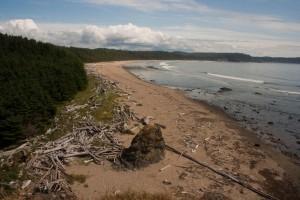 A dock that washed up along a remote stretch of the Pacific coast in Olympic National Park in December is the most recent herald of one of the most important environmental issues of 2013 facing the Pacific U.S. states and Canada’s province of British Columbia. The tsunami that devastated northeastern Japan on March 11, 2011 is estimated by Japan’s Ministry of Environment to have washed away 5 million tons of debris, a significant portion of which has been drifting with the currents across the Pacific Ocean. The National Oceanic and Atmospheric Association (NOAA), which is tracking the debris, had received more than 1,400 reports of possible tsunami debris and confirmed 17 as definite as of December 2012. This number is anticipated to increase in the months ahead.
A dock that washed up along a remote stretch of the Pacific coast in Olympic National Park in December is the most recent herald of one of the most important environmental issues of 2013 facing the Pacific U.S. states and Canada’s province of British Columbia. The tsunami that devastated northeastern Japan on March 11, 2011 is estimated by Japan’s Ministry of Environment to have washed away 5 million tons of debris, a significant portion of which has been drifting with the currents across the Pacific Ocean. The National Oceanic and Atmospheric Association (NOAA), which is tracking the debris, had received more than 1,400 reports of possible tsunami debris and confirmed 17 as definite as of December 2012. This number is anticipated to increase in the months ahead.
The removal of earthquake and tsunami debris in Japan has been a highly contentious process. This is in large part a consequence of the Fukushima Daiichi nuclear plant disaster, which galvanized citizens in many communities across Japan against their towns accepting debris from devastated communities—even those located nowhere near the nuclear plant—out of fear of radioactive contamination. In contrast, nuclear radiation is not a significant concern in relation to the debris approaching North America. More pressing is the potential threat posed by invasive species carried with the debris to the fragile coastal ecosystems.
The harbinger of the invasive species challenge arrived in June 2012 when a Japanese fishing dock washed up on the Oregon coast. More than two tons of plants and animals were removed from the dock. Many of these were native to Japan and had survived the long trek across the Pacific. Of the more than 90 non-native species found on the dock, two species—wakame and the Northern Pacific sea star—are included on the global list of 100 worst invasive species. In their initial assessments, scientists have found as many as 50 species native to Japan on the dock in Olympic National Park.
How could invasive species from the tsunami debris affect sustainability? According to the U.S. federal government’s Aquatic Invasive Species Task Force, aquatic invasive species present a greater threat to biodiversity than pollution, overharvest, and disease combined. They cost billions of dollars each year in economic impacts—not just to native fish populations and aquaculture, but also through degrading water quality, choking water sources from irrigation canals to industrial pipelines, and spoiling pristine environments that attract tourism. Additionally, they present risks to public health by carrying diseases, as well as through pollution generated by the use of toxic chemicals in controlling them.
NOAA’s maps chart a vast range across which tsunami debris could wash up, covering extremely remote areas from Alaska down through California and also Hawaii. The task of locating debris will be comparable to finding a needle in a haystack. However, the combination of debris tracking efforts, awareness campaigns by federal and state authorities, and considerable media attention during the past nearly two years has thus far helped drive rapid responses and generate public interest in this issue. These will all play an important role in managing the potential environmental and economic challenges ahead as more debris completes its journey across the Pacific.
Image by Author

